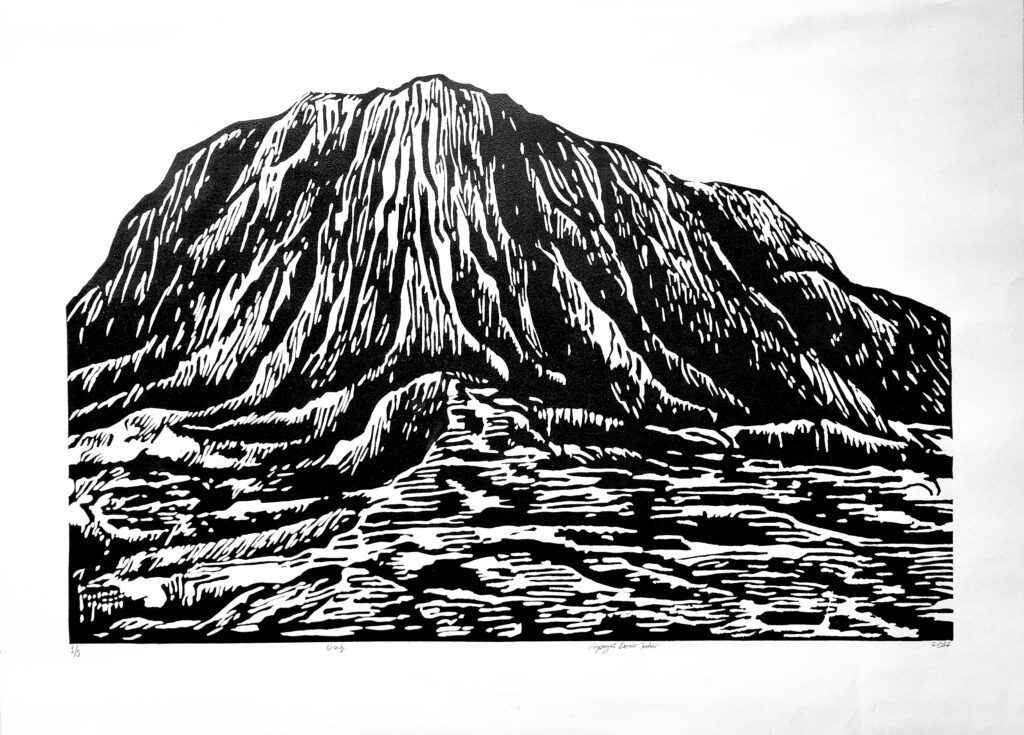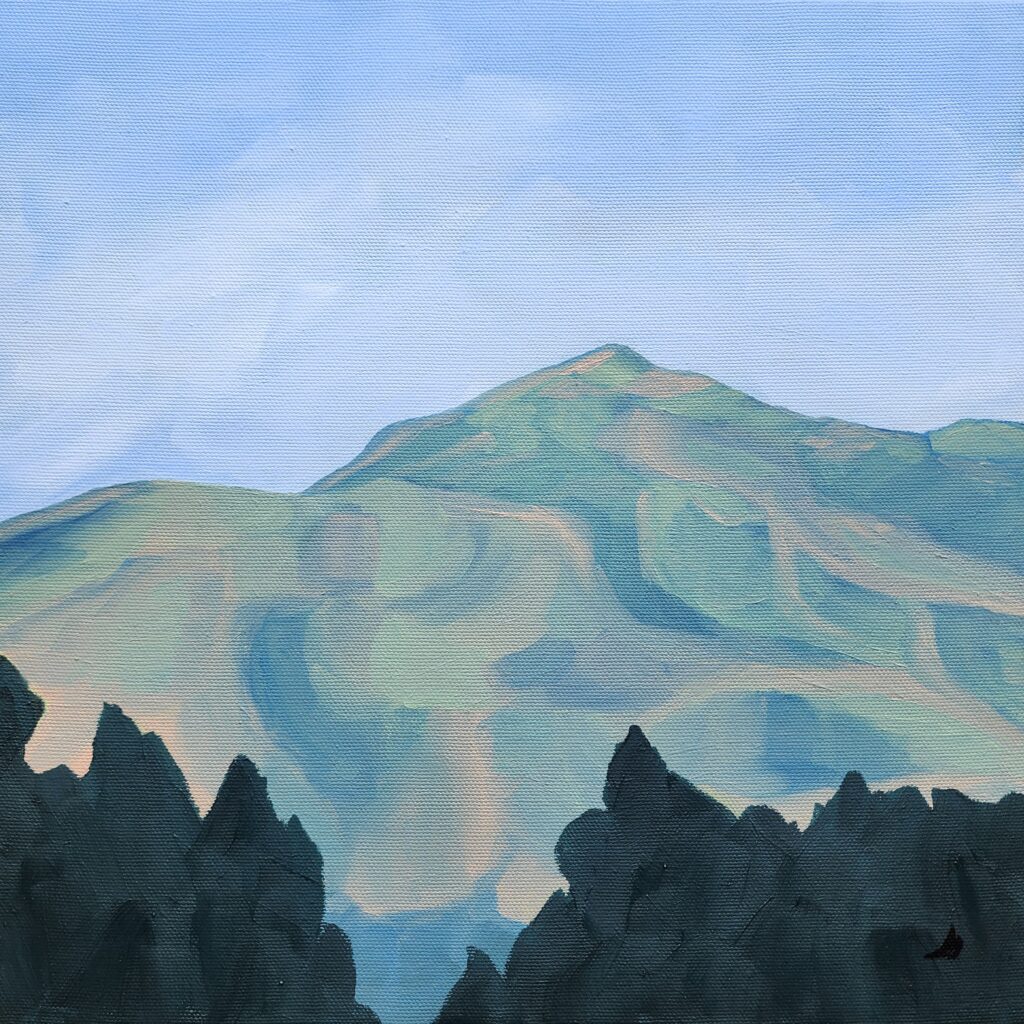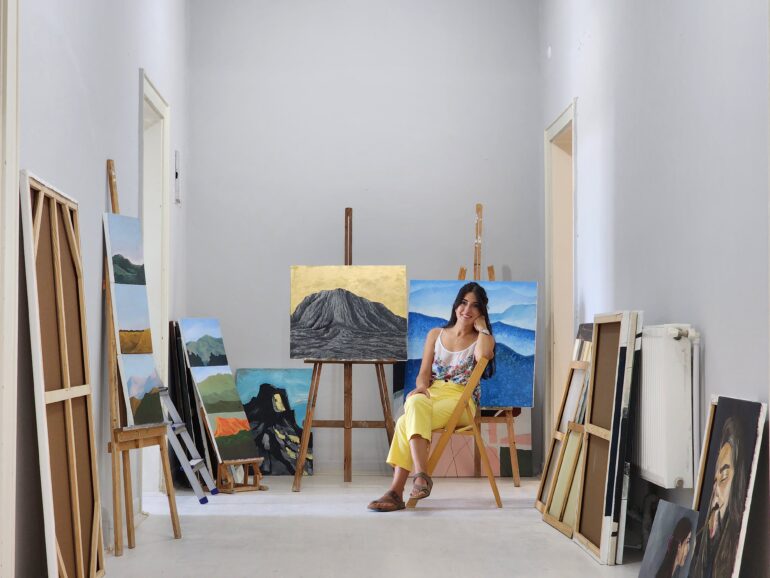Ayşegül Demir Tatar (born in Mersin, Turkey in 1991) studied art at Sakarya University and is an art educator as well as a practising artist. She has exhibited in Turkey and internationally, most recently taking part in the Bodrum Art Fair and exhibiting in the New York Lights Exhibition in NYC.
Demir Tatar works in a variety of mediums, ranging from linocut to painting, and Mountains are often the subject of her artworks. She seems drawn to the symbol of a mountain as it represents stability, patience and gradual evolution, which could be viewed as a metaphor for her own development as an artist. Her paintings and prints of Mountains captured at different times of day and night are reminiscent of Cezanne’s Impressionist studies of Mont Sainte-Victoire in France, which became one of the iconic artist’s most repeated and varied subjects. Demir Tatar veers between Impressionism and Abstraction in her style, her artworks capturing the essence of a time and a place. She is definitely one to watch.
Culturalee talks to Turkish artist Ayşegül Demir Tatar about her artistic practice, her fascination with mountains and the emerging art scene of Bodrum, and recent exhibitions in the USA and Turkey.
You recently took part in the Bodrum Art Fair. Istanbul has been a respected centre of contemporary art for many years with the Istanbul Biennial and a huge selection of galleries, plus it obviously has a rich cultural history. Bodrum seems to have a burgeoning contemporary art scene. What are your observations of the art scene in Bodrum as a Turkish artist featured in the Bodrum Art Fair?
Taking part in the Bodrum Art Fair has been a very exciting experience for me. As you mentioned, Istanbul’s long-standing central position in contemporary art and its rich cultural heritage have, of course, played an important role in Turkey’s art scene. I have had the opportunity to experience this fascinating atmosphere many times before. Most recently, an award-winning work of mine was exhibited at ArtContact Istanbul International Contemporary Art Fair. However, Bodrum’s contemporary art scene has also been developing rapidly in recent years and is very dynamic.
Bodrum has been an important cultural centre throughout history, and this seems to have nurtured an interest in contemporary art. One of the most important things I observed at the Bodrum Art Fair was the high level of interest and participation in the arts from both locals and international visitors. This shows that Bodrum is taking important steps towards becoming not only a tourist destination but also a contemporary art centre.
In addition, Bodrum’s natural beauty and the enchanting atmosphere of the Mediterranean Sea provide the perfect backdrop for artistic inspiration. For many artists, this is an environment that encourages creativity. Therefore, I would not be surprised to see more art events and gallery openings there. Bodrum has the potential to carve out its own unique place in the art world, and I believe this potential will only grow in the coming years. I am delighted to be part of this growth.

Mountains are a dominant feature in your art, and you have explored them in various mediums including oil paintings and linocuts. What is it about Mountains that draws you to them as your subject – is it a metaphorical notion of climbing a mountain and overcoming personal or global issues, or a more literal appreciation of the beauty of these majestic natural phenomena?
Mountains, whose formation processes span millions of years, are a great source of inspiration for me. The patient and long-term evolution of mountains reminds me that my art should also be in a constant state of transformation. My search for self-expression through various mediums emerged as a result of this transformation process. I position mountains not only as a natural form, but also as a symbol of human desires, goals, and even the unattainable. Think of something you desire intensely and have not yet achieved. You have seen it, felt its presence, but have not yet fully experienced it. It is a kind of passion for the unattainable, and I express this passion through mountains. This feeling of distance is both an artistic and personal source of motivation for me.
How did you get involved in the New York Lights exhibition this year, and what made you decide to use linocut as a medium for the Mountain image you exhibited there?
When I was a child, I saw photographs of New York City in a magazine and I was fascinated by it. This fascination inspired me to paint NYC. I learnt more and more about NYC over the years and it became like a huge work of art for me. I promised myself that one day I would fully experience this work of art. The city was like a mountain I saw from far away. I was aware of its existence, I could see it, but I had not yet been able to go there and experience it.
The New York Lights exhibition offered me an opportunity to physically exhibit my work in NYC. I was very happy that the jury thought I should take part in this project. Moreover, my mountain linoleum print, which symbolises the unattainable, would reach there thanks to this exhibition. In fact, I can say that my work was completed with the exhibition in NYC.
The reason I chose the linocut technique was that I wanted to capture the hard and textural structure of the mountains effectively. This technique allowed me to depict the patient and long evolution processes of the mountains with sharp and strong lines. In addition, the manual labour involved in making linoleum prints has also contributed to my art as another way of reflecting themes such as patience and perseverance in achieving my desires.
You also exhibited images of mountains in Bodrum this year, this time in the medium of oil painting. The six oil paintings you exhibited show the mountains illuminated by light at different times of day, evoking Monet’s impressionistic studies of the same view at different times of day, or Cezanne’s studies of mountains in france. Are you influenced by the impressionists or are there any other artists that particularly inspire you?
Cézanne’s obsession with Mont Sainte-Victoire and the transformation of this obsession into a passion has deeply affected me since my student years. It is said that he often referred to Mont Sainte-Victoire as a person, almost giving it a personality. The process of transferring what he saw with his eyes to the canvas with his imagination and thus the mountain gaining a personality is also very meaningful for me. Here, rather than external reality, an inner perspective comes to the fore. The fact that this is an intellectual process that goes beyond seeing is an approach that I care about while painting. I feel similar emotions in Georgia O’Keeffe’s arid mountains. Especially in Pedernal Mountain, which she painted from several different angles, it is possible to see the same intellectual process. This inner discovery and emotional connection influences the way I deal with mountains in my work from beginning to end.

Can you give a bit of insight into your technique and process? For example do you paint the mountains ‘En Plein Air’ or from photographs, do you start with a sketch or dive straight in? Do you depict mountains that exist in real life, or are they figments of your imagination?
Sometimes I scribble the mountains I see in my dreams in my sketchbook as soon as I wake up and I often make use of these dream images. I have the ability to continue my dreams during brief awakenings and to steer them in the direction I desire. As a lucid dreamer, this ability always makes my work easier when painting mountains. Therefore, I can say that the mountains in my works take place in my art as a mixture of both my imagination and my observations.



